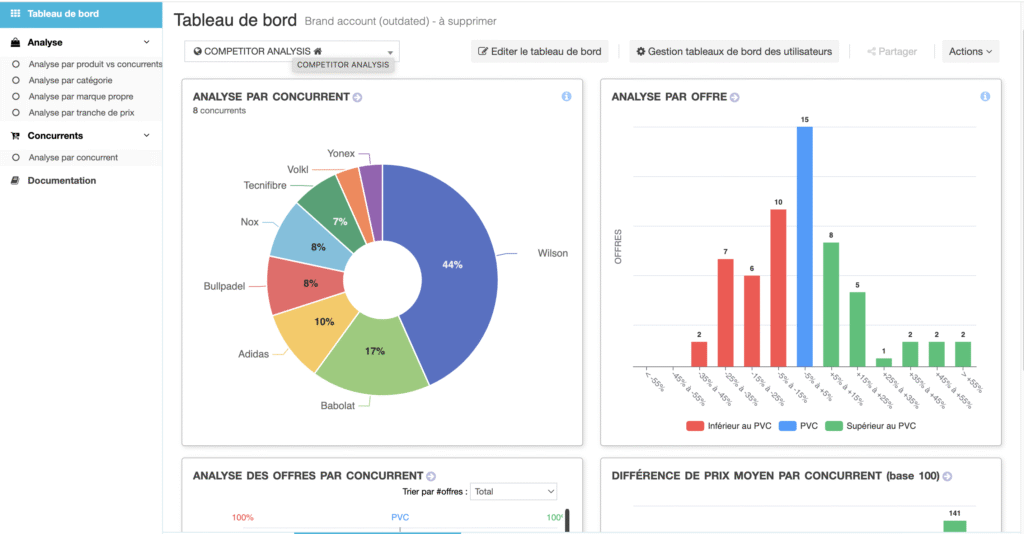As competitors grow ever more agile, price remains one of the most powerful levers to grab attention, trigger purchases, and protect margins. But without a clear methodology, pricing intelligence can quickly become time-consuming, imprecise, and hard to act on. Data piles up, but decisions stall. The real value lies not in the data itself, but in how systematically it’s analyzed and intelligently used.
In this article, we break down a complete methodology for pricing intelligence—from defining your scope to fully automating your process, including data collection, analysis, and continuous monitoring.
You’ll learn how to structure your approach, choose the right tools, avoid the most common mistakes that hurt competitiveness, and how Price Observatory can help optimize your pricing strategy.
What Is Pricing Intelligence and Why Does It Matter?
Pricing intelligence refers to all the actions involved in collecting, centralizing, and analyzing your competitors’ prices—either for identical products or for equivalent references. It requires a structured, methodical approach to get a clear, up-to-date view of the market.
It differs from:
- Competitive intelligence, which covers broader aspects like product strategy, communication, channels, innovation, and partnerships.
- Pricing science (or pricing optimization), which relies on data science and AI to model demand, forecast competitor reactions, and optimize prices in real time.
The goals of pricing intelligence are multifaceted:
- Stay competitive by adjusting your pricing to actual market conditions—without falling into profit-eroding price wars.
- Protect and grow your margins with a granular understanding of profitability thresholds and competitor tactics.
- Adapt your positioning to market movements and validate or fine-tune your strategy as needed.
- Identify commercial opportunities, such as poorly timed competitor promotions, stockouts, or exploitable price gaps by segment or region.
Pricing intelligence becomes your strategic radar—it guides decisions, reduces uncertainty, and turns price data into a long-term competitive advantage.
The Foundations of a Strong Pricing Methodology
To turn pricing intelligence into a true strategic asset—not just a passive data collection effort—you need a clear framework.
- Start by defining a precise scope: Determine which products, ranges, competitors, and channels you want to monitor before collecting any data.
- Ensure data reliability: Sound decision-making depends on accurate data. That means robust product matching (via EAN, GTIN, or visual recognition) and regular validation to avoid mismatches that distort results.
- Set the right monitoring cadence: Collection frequency should reflect your market dynamics—daily for volatile sectors like electronics or e-commerce, and weekly or monthly for more stable ones.
- Analyze, don’t just collect: Effective pricing intelligence goes beyond gathering numbers. It should produce clear KPIs: price indices, trends by channel, competitiveness ratios, and share-of-shelf metrics.
- Integrate pricing insights into your business processes: Your pricing, marketing, procurement, and sales teams should all be able to act on these insights immediately.
Without this structure, pricing intelligence becomes just another spreadsheet—dormant, underused, and with little impact on your competitiveness.

The Key Steps of an Effective Pricing Intelligence Methodology
How can you implement effective pricing intelligence? It’s not something you can improvise.
To turn raw pricing data into strategic decisions, you need to follow a clear, structured process.
Here are the 7 essential steps to building a robust, sustainable methodology.
1. Define Your Pricing Scope
Start by precisely outlining the scope of your monitoring.
This means identifying the strategic products or ranges to focus on, the priority competitors to track, and the key distribution channels and geographic zones.
A well-defined scope helps focus resources on high-value data. Begin with high-volume or high-margin items, then expand gradually.
Also monitor areas with aggressive competition or segments prone to price wars.
A scope that’s too broad can dilute your analysis, while one that’s too narrow may cause you to miss key opportunities and weak signals.
2. Choose the Right Tools and Methods
Tool selection depends on your catalog size, number of competitors, and your internal capacity to process data.
- Manual collection: Suited for small operations or limited SKUs, but extremely time-consuming.
- Specialized SaaS tools: Enable automated scraping, centralized data, and real-time alerts.
- API integration with PIM/ERP systems: Ensures up-to-date product data and seamless integration into your pricing processes.
An effective tool must strike the right balance between accuracy, update frequency, and usability.
The ideal solution combines automation and customization—just like Price Observatory does.
3. Collect Relevant Data
Effective pricing intelligence goes beyond just collecting the displayed price.
You need to include all factors that impact perceived value:
- Gross or net price (with or without tax)
- Shipping fees and delivery times
- Promotions (instant discounts, promo codes, bundles)
- Included services (warranty, installation, support)
- Stock availability
- Packaging and product variations
This level of detail avoids misleading comparisons and gets you closer to the real price paid by the customer.
Modern tools enrich your data with these variables automatically, giving you a consistent and reliable foundation for analysis. The more structured your collection, the more meaningful your decisions.
4. Ensure Accurate Product Matching
Product matching is the step that ensures data relevance. It consists of pairing each of your SKUs with its closest competitor equivalent.
Common methods include:
- Unique identifiers (EAN, GTIN)
- Image recognition to identify visually similar items
- Semantic AI to match listings with different titles but similar specs
Poor matching leads to flawed analysis.
Top-tier solutions like Price Observatory combine automated matching with manual validation—especially important in technical categories or those with many product variants.
5. Analyze the Data
Once your data is collected and validated, the next step is interpretation.
- Price indices to evaluate your overall competitiveness
- Trend analysis: Identify recurring increases or decreases by season, channel, or competitor
- Segmentation by range, category, or geography to prioritize actions
You can also include price elasticity models to predict the impact of changes on demand and margin.
The goal is to go beyond static observation and develop a dynamic, strategic understanding of your market.
6. Decide and Take Action
Insights must lead to concrete actions. Examples include:
- Dynamic repricing to respond to market shifts
- Negotiating better supplier terms if competition is eroding your margins
- Targeted promotions to counter a competitor’s campaign
- Stock clearance when needed
The key is speed of execution. A delayed decision often loses its impact.
That’s why pricing intelligence must be fully integrated into your operational processes to become a true performance lever.
7. Set Up Continuous Monitoring
Pricing intelligence is not a one-time audit—it’s a continuous process.
- Set automatic alerts for significant price deviations
- Keep your reporting updated with KPIs like price competitiveness, average margin, and share of shelf
- Regularly adjust your scope and tools to stay aligned with your goals and market evolution
This proactive approach helps you anticipate trends rather than just react to them, making pricing intelligence a permanent pillar of your commercial strategy.
Embracing Automation and Data Science
Automation is now the cornerstone of successful pricing intelligence.
SaaS platforms like Price Observatory allow you to monitor thousands—or even millions—of SKUs across multiple channels, countries, and currencies, with update frequencies adapted to your market.
These solutions provide:
- Significant time savings, eliminating the need for manual collection
- Broad and consistent coverage across all relevant marketplaces and territories
- High data accuracy, powered by smart collection and cleansing algorithms
What to Look for in a Tool
A good pricing tool should offer seamless integration with your existing systems (PIM, ERP, BI), a user-friendly interface for data analysis, and configurable alerts.
Multilingual support and local format compatibility (taxes, price structures) are also essential.
The Role of Data Science
Data science transforms pricing intelligence into a proactive strategy.
With AI and machine learning, it becomes possible to:
- Forecast pricing trends using predictive models
- Analyze price-demand elasticity to understand how pricing changes impact performance
- Identify long-term competitor behaviors and simulate pricing scenarios
By combining automation and predictive analytics, pricing intelligence evolves from a simple monitoring function to a strategic decision-making tool—helping you stay ahead of the competition before they even make a move.

Common Mistakes to Avoid
Effective pricing intelligence requires a clearly defined scope, reliable data, contextualized analysis, and quick action to remain competitive.
Without a real methodology, you risk bias, wasted time, and lost opportunities. Here are the most frequent pitfalls—and how to avoid them.
Poor Product Matching
Comparing items that aren’t truly equivalent (differences in size, bundles, product versions, or refurbished status) skews your results.
For example, comparing a 256 GB smartphone to a competitor’s 128 GB model will lead to inaccurate conclusions. A reliable tool should leverage EANs, GTINs, or visual recognition to ensure meaningful comparisons.
Collecting Without Acting
Gathering data without translating it into actionable decisions (repricing, targeted promotions, supplier negotiations) immobilizes valuable analytical capital.
Your indicators should drive real, measurable actions.
Uncalibrated Scope
A scope that’s too broad will dilute your insights, while one that’s too narrow will give you a fragmented market view.
For instance, only tracking French prices might cause you to miss an international price war.
Neglecting Qualitative Factors
Pricing intelligence isn’t just about numbers—stock availability, visual quality, product descriptions, and customer reviews also affect perceived value and competitiveness.
Ignoring these factors reduces the strategic impact of your monitoring.
Measuring the Effectiveness of Your Pricing Methodology
Pricing intelligence only creates value if you can measure its impact. That’s why it’s crucial to track relevant KPIs, such as:
- Price Competitiveness Rate: The percentage of SKUs priced within the optimal market range. This gives a clear view of your competitive position.
- Average Margin Before/After Adjustments: Determines whether pricing decisions are improving profitability without harming sales volume.
- ROI of Pricing Actions: Measures the direct financial impact of pricing actions (repricing, promotions, supplier renegotiations) on revenue and margin.
- Price-Based Market Share: Evaluates your market weight relative to your pricing position compared to equivalent competitors.
To be effective, these KPIs must be tracked consistently (weekly or monthly, depending on your sector) and integrated into a dynamic dashboard—like the one provided by Price Observatory.
Finally, continuous improvement is key: analyze your KPIs, identify areas for progress, test new actions, and measure their impact again.
This iterative approach ensures your methodology evolves with the market and keeps you competitive over the long term.
Conclusion
Today, structured pricing intelligence is no longer just a monitoring tool—it’s a true strategic lever for companies aiming to maintain long-term competitive advantage.
By combining reliable data, relevant analysis, and fast decision-making, you can stay competitive, protect your margins, and adapt your positioning in real time to market shifts.
In a market where competitors adjust their prices within hours, flying blind means losing ground.
In contrast, a well-structured and properly equipped methodology transforms price tracking into concrete opportunities: winning market share, optimizing promotional campaigns, and reinforcing your products’ perceived value.
Try Price Observatory now, our automated pricing intelligence solution.
In a personalized demo, you’ll discover how to go beyond data collection and build a proactive, data-driven pricing strategy focused on growth.
Request your demo today and take the lead on your competitors.